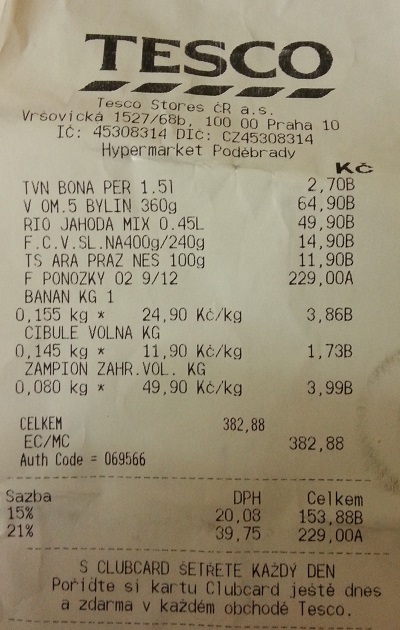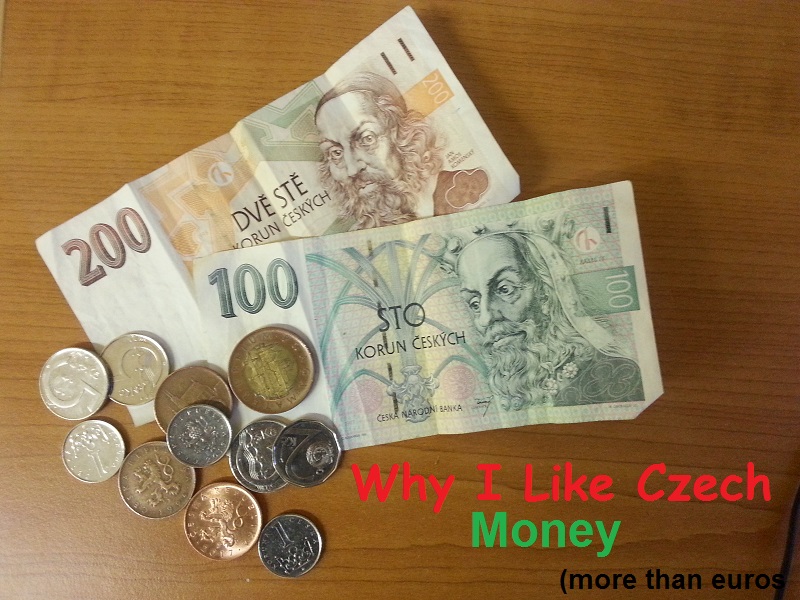I’ve been using Czech money for nearly a month now and I have to say that I like it. In fact, I prefer it to the euro and that’s my main currency. Before I arrived in the Czech Republic, I’d been using euros for over two-and-a-half years, but it only took me a couple of days to become used to doing all my spending in Czech koruna (Kč). There are some pretty big differences with way Czech money works though.
The first thing I had to learn to deal with was drawing money out of machines. I felt like I was withdrawing unusually high amounts of cash. When I arrived in Prague and used a cashpoint at the train station the minimum amount it would let me with withdraw was 1,000 Kč. It seemed like such a lot of money at the time, but it’s only around €39. Since then I’ve discovered some machines allow you to withdraw as little as 500 Kč, but that appears to be about as low as you can go.
The first few purchases I made using Czech money also felt a little a strange. Handing over 135 Kč to a street vendor in exchange for a small plate of food and a bottle of coke seemed very extravagant. In reality, I was only paying €5.26.
Something that really surprised me was the choice of metal that’s used for making the coins. In the United Kingdom, the coins with the least value (2p + 1p) are made of copper-plated steel and are often referred to as “coppers”. Most of the coins of higher value (5p, 10p, 20p, 50p) are made of nickel-plated steel. It gives them a silver appearance and is probably meant to indicate their higher value. One pound coins are made of a combination of metals that provide them with a two-tone silver-gold effect. It’s a similar situation with euros. The lower value coins (1c, 2c, 5c) look coppery. The colour of the metal becomes more yellow as the value goes up (10c, 20c, 50c), and one euro and two euro pieces are made of a combination of metals that give them a two-tone, yellow-silver appearance. It’s the other way around with Czech money.
With Czech money, the lowest value coins (1 Kč, 2 Kč, 5 Kč) are constructed from a shiny metal that looks like silver. The 10 Kč coins look like copper, the 20 Kč coins are a tad more yellow-looking, and the 50 Kč coins contain a combination of metals that give them a two-tone look that is more coppery than anything else. I’m used to them now, but the coins colours originally gave me a tiny case of culture shock. However, the biggest difference between Czech money and the euro is the way the system works.
A euro is made up of 100 cents, as is an American dollar. The British pound is actually 100 pence. A lot of currencies work in a similar way, but the Czech koruna is actually more like a cent than a euro. When you get to 100 you just keep on counting. A koruna is not a smaller part of something else.
 Although 1 Kč is as low as it goes in Czech money, one day when I looked at one of my supermarket receipts, I was surprised to discover many items I’d purchased were charged at prices that contained fractions of a koruna. Presumably, if the total spend contains a fraction of a koruna, and you want to pay in cash, they must round it up or down.
Although 1 Kč is as low as it goes in Czech money, one day when I looked at one of my supermarket receipts, I was surprised to discover many items I’d purchased were charged at prices that contained fractions of a koruna. Presumably, if the total spend contains a fraction of a koruna, and you want to pay in cash, they must round it up or down.
I always use my card in the supermarkets and the system appears to be set up in a way that allows my balance of korunas to be reduced by amounts that include fractions. If I pay 382.88 Kč with my card, that’s what leaves my account. I’ve only seen this in supermarkets. Bars, restaurants, coffee shops, ice cream parlours, etc., don’t seem to split the koruna into fractions.
All in all, there are a number of differences between Czech money and the euro, but I like it better and there’s a simple reason for that. With Czech money I’ve discovered it’s really easy to get rid of the smaller coins instead of having them collect up in the pocket. With the euro, all the smaller coins can mount up because it’s frustrating and embarrassing to have to stand counting out a lot of change at the checkout. All those one and two cent pieces can be annoying. It’s a little better in the Netherlands because they don’t use them. Five cents is as low as it gets and everything is rounded up or down but the small coins still tend to mount up. It’s the same with British pennies. In the Czech Republic, it’s easy to count out a few Koruna to pay for a beer or some other low-price item, so there is no need to carry all that extra weight around in your pocket.
– – – – –
– – –
– – –
– – – – –
